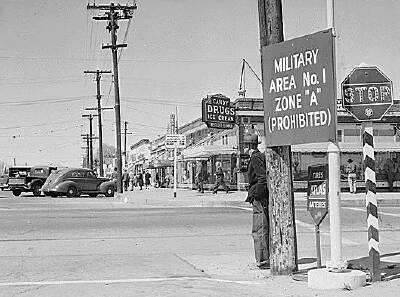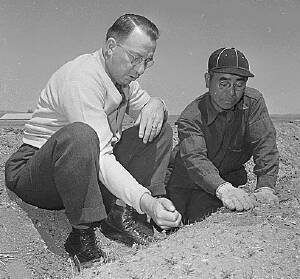|
WAR RELOCATION AUTHORITY WASHINGTON
April 20, 1942
MEMORANDUM FOR MEMBERS OF CONGRESS
So many requests for information about the relocation of
Japanese who are now being evacuated from Military Area Number One on
the Pacific Coast are coming to the War Relocation Authority from
Members of Congress, that I am submitting herewith a brief,
hastily-prepared report.  "Sign on main street designating military zone." (Lancaster, Calif., 04/02/1942) May I call attention especially to the fact that despite numerous newspaper statements on the question, a wage policy in connection with public work by evacuees has not been determined. Sincerely yours, (signed) M. S. Eisenhower Attachment
April 20, 1942
INFORMAL REPORT OF THE WAR RELOCATION AUTHORITY
The War Relocation Authority has been moving rapidly toward an organization capable of handling the total problem of relocating approximately 120,000 Japanese being evacuated from the West Coast military area. Washington, D. C. -- The War Relocation Authority does not as yet have space of its own. Consequently, for the time being it is occupying a few rooms in the Administration Building, Department of Agriculture. M. S. Eisenhower, formerly Land Use Coordinator of the Department of Agriculture, is Director of WRA. Colonel E. F. Cress, of the United States Army, is Deputy Director. Philip M. Glick is Solicitor, John Bird is Director of Information, and Leland Barrows is Executive Officer. San Francisco, California -- The western regional
office of WRA is located at the Whitcomb Hotel Building, San Francisco.
E. R. Fryer, formerly
Superintendent of the Navajo Indian Reservation,
is Regional Director. The regional office has three major branches: (1)
An Economic Management Each war-duration project will be managed by a Project Director. The project organization will include community works, community services, war works, public works, housing, employment, supply, transportation, and plant maintenance. Each project will be as productive as possible, and it will be the policy to encourage the evacuees themselves to develop the highest degree of community services consistent with the situation. Site Selection -- Because of the tremendous pressure to find adequate sites so that the construction of housing and other facilities could get under way, the War Relocation Authority obtained, immediately after it was established by the President, the cooperation of numerous agencies in the West. With personnel loaned by these agencies, WRA set up four regional teams, each one composed of qualified persons assigned from the Soil Conservation Service, Forest Service, Office of Indian Affairs, Bureau of Reclamation, Bureau of Agricultural Economics, Farm Security Administration, and Federal Security Agency. Persons on these teams are expertly qualified on questions of water supply, soil, climate, crops, and other physical and economic factors. Despite the general scarcity of available water and despite other limitations imposed by climate and soil, these teams are finding a number of reasonably promising sites. One reception or relocation center has been located at Manzanar, in the Owens Valley of California; a second has been established on the Colorado River Indian Reservation near Parker, Arizona, and a third on the Gila, about 40 miles southeast of Phoenix, Arizona. Other locations will be announced soon. Development of Relocation Policies -- The program initially planned by the War Relocation Authority was based on the need for orderly evacuation of all Japanese aliens and American-citizen Japanese to large reception centers on public land where public and other types of work could be undertaken. The following five-point program was considered: 1. Useful public works -- such as land subjugation, flood control, and development of natural resources. To enlist the cooperation of States affected, a meeting was called at Salt Lake City April 7. It was an executive session, closed to the press, and was attended by governors or their representatives, attorneys general or their representatives, and other State and Federal officials from 10 far western States. The conference revealed the fact that the problem of war-time relocation of Japanese would be more difficult and dangerous than originally conceived. Two major forces were made evident: (1) Some agricultural areas are anxious to obtain the labor of evacuees but wish to have assurances that communities will be protected and that evacuees will later be withdrawn; (2) practically all States are opposed to a wide dispersal of Japanese in their States and insist that evacuees be prevented from acquiring land, that evacuees be withdrawn when the war is over, and that all evacuees be placed in Federally-guarded areas. In view of the fact that the Army cannot disperse its troops to provide military guard for small groups of evacuees working in agriculture, the Authority will be compelled in the early stages of the program to carry out all relocation on large Federally-supervised and protected projects. Naturally this limits the economic opportunities available and eliminates the possibility of the last two categories of opportunities, namely, it eliminates for the time being private employment outside of relocation centers, and the development of self-supporting communities. Following the Salt Lake conference, the Authority announced that the minimum requirements for reception centers were as follows: 1. All relocation centers must be located on public land where improvement at public expense will become public, not private, assets. Any land acquired for relocation centers wil remain in public ownership. Project Work -- As previously indicated, projects have been approved for relocation of 10,000 evacuees at Manzanar, Owens Valley, California; 20,000 evacuees at Parker, Arizona, on land leased from the Colorado Indian Reservation, and for the relocation of 10,000 on the Gila River, southeast of Phoenix, Arizona. At Parker, evacuees will engage in the development of approximately 80,000 acres of land for irrigation and will give immediate attention to the development of subsistence farming. Construction of housing is nearing completion on this project and evacuees will soon start moving in. Construction of housing is now starting on the Gila project where evacuees will operate more than 7,000 acres of irrigable land for the production of large quantities of vegetable crops needed in the "Food for Freedom" program. In addition, the evacuees at Gila will round out their year-long employment by development of 8,000 acres of partially subjugated land. Immediately Ahead -- A number of other projects are in the last stages prior to approval. On the whole, it can be said that the outlook for projects meeting specifications of the Authority is fairly satisfactory. Every emphasis will be given to completing the schedule of projects as soon as possible so that there may be an orderly movement of evacuees from assembly centers (temporary locations within Military Area Number One) to relocation centers where they will be established for the duration of the war. Wage Policies -- A great deal of misinformation has been circulated with respect to wages that might be paid to evacuees for work on public projects. Neither the Wartime Civil Control Administration, which handles evacuation for the Western Defense Command, nor the War Relocation Authority has formulated a wage policy.
-- Table of
Contents --
|
 branch
under which are the divisions of public
works, industrial management, agricultural management, site selection
-- headed by
branch
under which are the divisions of public
works, industrial management, agricultural management, site selection
-- headed by